|
|
 |
|
Calanoida ( Order ) |
|
|
|
Calanoidea ( Superfamily ) |
|
|
|
Megacalanidae ( Family ) |
|
|
|
Megacalanus ( Genus ) |
|
|
| |
Megacalanus ohmani Bradford-Grieve, Blanco-Bercial & Boxshall, 2017 (F,M) | |
| | | | | | | Ref.: | | | Bradford-Grieve, Blanco-Bercial & Boxshall, 2017 (p. 44, figs. F,M) | 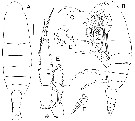 Issued from : J.M. Bradford-Grieve, L. Blanco-Bercial & G.A. Boxshall in Zootaxa, 2017, 4229 (1). [p.44, Fig.17]. Female (from 05.350°N, 133.583°W): A-B, habitus (dorsal and lateral, respectively); C, forehead (lateral); D, caudal ramus (dorsal); E, P1 (anterior view: mc = macula cribrosa); F, detail of large spine on anterior surface of P1 basis. Scale bars: 1.0 mm (A, B); 0.1 mm on remaining figures. Nota: - Posterior corners of pedigerous somite 5 with short blunty rounded posterior borders extending 1/4 of distance along genital double-somite in dorsal view and only as far as genital bulge in lateral view; posterior borders appearing rounded in dorsal view. - P1 outer spines on exopods segments 1 and 2 extending only slightly beyond base of following, more distal spine and exopodal segment 2 has macula cribrosa located at distal 1/3 from base of distolateral spine on lateral border. - P1 outer spines on exopodal segments 1 and 2 extending only slightly beyond base of following, more distal spine and exopodal segment 2 has macula cribrosa located at distal 1/3 from base of distolateral spine on lateral border.
|
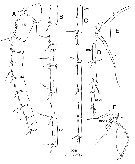 Issued from : J.M. Bradford-Grieve, L. Blanco-Bercial & G.A. Boxshall in Zootaxa, 2017, 4229 (1). [p.45, Fig.18]. Female (from 05.350°N, 133.583°W): A, A1 ventral surface of ancestral segments I-XI; B, A1 ancestral segments XII-XVii; C, A1 ancestral segments XVIII-XXIII; D, A1 ancestral segments XXIV-XXVIII; E, detail of aesthetasc (a), modified seta (ms) and macula cribrosa (mc) distally on segment XXV; F, detail of terminal part of A1 (a = aesthetasc, mc = macula cribrosa). Scale bars: 1.0 mm (A-D); 0.1 mm on remaining figures. Nota: - Dorsal surface A1 segments I-V each with very small hair sensillum of which those on segments I-IV each accompanied by macula cribrosa; ventral surface on ancestral segments XIV to XVII with distal row of 19-20, 31, 31-36, 30 teeth respectively.; ancestral segments XV and XVI smooth, without distoposterior row of blunt teeth.
|
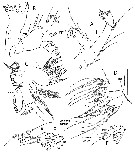 Issued from : J.M. Bradford-Grieve, L. Blanco-Bercial & G.A. Boxshall in Zootaxa, 2017, 4229 (1). [p.46, Fig.19]. Female (from 05.350°N, 133.583°W): A, A2; B, Md; C, Mx1 (mc = macula cribrosa); D, inner view of Mx2; E, detail of inner view of terminal part of Mx2 §B = basal endite, Ri 1-4 = endopod segments 1-4; F, outer view of endopod of Mx2. Scale bars: 1.0 mm (D); 0.1 mm on remaining figures.
|
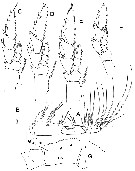 Issued from : J.M. Bradford-Grieve, L. Blanco-Bercial & G.A. Boxshall in Zootaxa, 2017, 4229 (1). [p.47, Fig.20]. Female (from 05.350°N, 133.583°W): A, Mxp; B, detail of bifurcate spinule from basis of Mxp; C, P2; D, P3; E, P4; F, P5; G, dorsal view of A1 ancestral segments I-V, showing hair sensilla (hs) and maculae cibbrosae (ms). Scale bars: 1.0 mm (A, C-G); 0.1 mm on remaining figures.
|
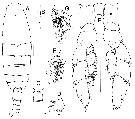 Issued from : J.M. Bradford-Grieve, L. Blanco-Bercial & G.A. Boxshall in Zootaxa, 2017, 4229 (1). [p.48, Fig.21]. Male (from 05.350°N, 133.583°W): A, habitus (dorsal); B, forehead (lateral); C, posterior corner of pedigerous somite 5 and urosomites 1 and 2 (lateral); D, caudal ramus (dorsal); E, P5 (L = left leg, R = right leg; posterior view); F, distal inner corner of left exopod segment 2 of P5 ; G, same (another specimen). Scale bars: 1.0 mm (A, C, E); 0.1 mm on remaining figures Nota: - P5 inner distal border of basis without setule. Left P5 exopodal segment 2 specialised seta with basal part longer than wide and lash longer than basal part. Right exopodal segment 3 inner border with series of hyaline ridges along distal 2/3, proximal 1/3 lined with fine setules. - The specialised seta on left P5 exopodal segment 2 is similar to that of M. princeps, M. frosti bur differs from the Pacific species M. ericae which has a much stumpier specialised seta with a lash that is shorter that the basal part
|
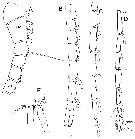 Issued from : J.M. Bradford-Grieve, L. Blanco-Bercial & G.A. Boxshall in Zootaxa, 2017, 4229 (1). [p.49, Fig.22]. Male (from 05.350°N, 133.583°W): A, left A1 ancestral segments I-VIII; B, ancestral segments IX-XV (note clavate seta on segment XI apparently knocked off but present in other specimens); C, ancestral segments XVI-XX; D, ancestral segments XXI-XXVIII; E, distal segment of left A1 (a = aesthetasc). Scale bars: 1.0 mm (A-D); 0.1 mm (E). Nota: Left A1 with clavate seta broken off ancestral segment XI in figured specimen leaving setal vestige, but present in other specimens
|
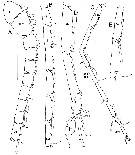 Issued from : J.M. Bradford-Grieve, L. Blanco-Bercial & G.A. Boxshall in Zootaxa, 2017, 4229 (1). [p.50, Fig.23]. Male (from 05.350°N, 133.583°W): A, right A1 segment I-XII (arrow indicates 'clavate seta'); B, ancestral segments XIII-XVIII; C, ancestral segments XIX-XXVIII; D, detail of segments XIX-XX; E, detail of segments XXI-XXIII; F, detail of terminal part of right A1. Nota: - Right A1 ancestral segment XI with distal clavate (club-shaped) seta (indicated by arrow); ancestral segment XIX with 1 fused gripping element extending beyond base of aesthetasc; segment XXI with 2 long overlapping gripping elements (proximal element with tip extending to base of asthetasc, distal element extending well beyond distal border of segment).
|
 Issued from : J.M. Bradford-Grieve, L. Blanco-Bercial & G.A. Boxshall in Zootaxa, 2017, 4229 (1). [p.66, Table 7]. Morphological characters after identification key of Megacalanus females and males. Compare to other species of genus. Main characters identification after species key : 1 - Head without crest in males and females. 2 - Posterolateral lappets of pediger 5 rounded in females and males.
| | | | | NZ: | 1 | | |
|
Distribution map of Megacalanus ohmani by geographical zones
|
| | |  Issued from : J.M. Bradford-Grieve, L. Blanco-Bercial & G.A. Boxshall in Zootaxa, 2017, 4229 (1). [p.34, fig.9]. Issued from : J.M. Bradford-Grieve, L. Blanco-Bercial & G.A. Boxshall in Zootaxa, 2017, 4229 (1). [p.34, fig.9].
Distribution of Megacalanus princeps (filled triangle), Megacalanus frosti (open triangle), Megacalanus ericae (filled square) and Megacalanus ohmani (open square). |
| | | | Loc: | | | Indonesia, West of Irian Jaya (R Banda Sea).
Type locality : 5.350° S, 133.583° E. | | | | N: | 1 | | | | Lg.: | | | (1316) F: 9,5-11,00; M: 10,70; {F: 9,5-11,00; M: 10,70} | | | | Rem.: | Bathypelagic.
For Bradford-Grieve & al; (2017, p.43) this species is similar to M. ericae Females and males of these two species may be distinguished by the shape of the posterior borders of pediger 5, and other characters bearing on the structure of A1. | | | Last update : 31/07/2018 | |
|
|
 Any use of this site for a publication will be mentioned with the following reference : Any use of this site for a publication will be mentioned with the following reference :
Razouls C., Desreumaux N., Kouwenberg J. and de Bovée F., 2005-2026. - Biodiversity of Marine Planktonic Copepods (morphology, geographical distribution and biological data). Sorbonne University, CNRS. Available at http://copepodes.obs-banyuls.fr/en [Accessed January 05, 2026] © copyright 2005-2026 Sorbonne University, CNRS
|
|
 |
 |










